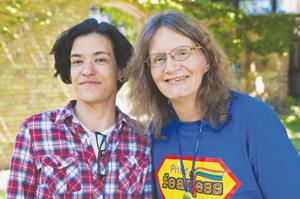For Susan Gakpa and Luka Sidaravicius, Pride is about moments of learning and surprise that are both personal and political.
Sidaravicius still vividly remembers reading a sign that proudly declared, “We support and love our trans son” in his first language, Portuguese.
“This was before I came out as trans, and it blew my mind,” he says. “There’s always something at Pride that makes me rethink, that challenges something I think I know.”
Gapka, likewise, recalls the city’s first Trans March, in 2009. “We had talked about having a Trans March for years and years,” she recalls. “When some people actually started a Facebook group, we didn’t know if people would show up.”
Hundreds did.
“It was exhilarating,” she says. “We went down Church St, and then just kept going. I can’t imagine what this year will be like for people who’ve never been to a Trans March.”
Now Sidaravicius, who leads Pride Toronto’s Trans Pride team, and Gapka, the first out trans member of Pride Toronto’s board of directors and a community liaison, are among the organizers working to create moments of learning, community building and surprise for others.
This year’s Trans Pride activities kick off with a 6pm rally in Norman Jewison Park on Friday, June 29, followed by the Trans March at 7:30pm. American Sign Language interpreters will be present at the rally, and accessibility-services volunteers will be present during the rally and march.
Throughout Pride weekend, volunteers at the Trans Space, just across from the 519 Church St Community Centre, will connect visitors to a wide range of resources in a non-judgmental environment. A rich lineup of trans and gender-variant artists will perform at the North Stage, next to the Trans Space.
Both organizers say this year’s official Pride theme, Celebrate and Demonstrate, couldn’t be more appropriate.
On the one hand, diverse trans communities have a lot to celebrate. Gapka, an advocate versed in public policy, points to the passage of Bill 13, the Accepting Schools Act, and the landmark passage of Bill 33, Toby’s Act, which amends Ontario’s Human Rights Code to prohibit discrimination based on gender identity and gender expression.
“Life is never for sure,” she says, chuckling. “I’ve always said that Pride will come and go every year, and the Monday after Pride, trans people still won’t have our human rights. But this year, we have our human rights, and that’s something spectacular to celebrate.”
Sidaravicius also points to gains in health and education, like the publication of Brazen, a unique and pleasure-centred safer-sex guide for trans women, by The 519.
On the other hand, significant areas of struggle remain. With Toby’s Act on the books, Sidaravicius says the challenge becomes making sure people know about their rights and available resources — and how to use them. “Now comes the hardest part: education,” he says.
Gapka also points to troubling federal actions, like airplane security identification requirements that place a burden on trans passengers and threats to healthcare benefits for transitioning members of the Armed Forces.
Addressing these concerns takes many forms, Gapka and Sidaravicius agree.
But celebrating and demonstrating — or, as Gapka says, “coming on out, catching some great performances and showing people we’re a force to be reckoned with” — is a great way for trans and genderqueer people and their allies to start.
In the video interview below Pride Toronto Executive Director Kevin Beaulieu comments on the trans march.

 Why you can trust Xtra
Why you can trust Xtra


